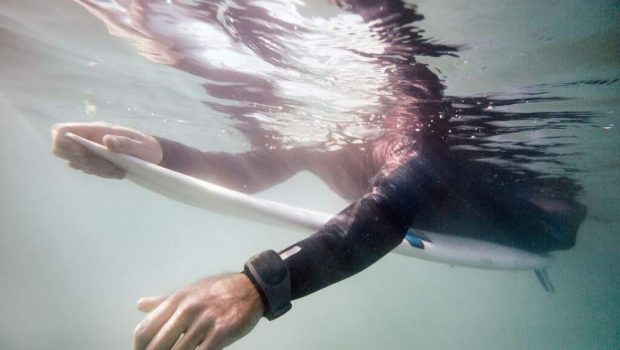Can You Avoid A Shark Attack?
According to ‘Trip Savvy, most shark attacks happen in the U.S. from April through October. The number of human-shark interactions is strongly correlated with time spent by humans in the sea. (International Shark Attack File) As the human population continues to expand and as interest in outdoor aquatic recreational activities increases, the incidence of shark attacks is expected to rise. Improved global communications between ISAF, scientific observers and beach safety organizations as well as increased coverage of sharks in the media has heightened public awareness of shark-related issues. This has led to an improved accounting of human-shark interactions. Is there anything you can do to protect yourself? The company Sharkbanz is on a mission to keep ocean enthusiasts safe from sharks in the seven seas.
Sharkbanz’s patented magnetic technology is the result of long term, ongoing scientific studies and testing. Sharkbanz utilize powerful permanent magnets to create an effective shark deterrent that’s always on and requires no batteries or charging. When sharks approach Sharkbanz, they detect the device’s strong electromagnetic field, which provides a sudden sensation that is thousands of times stronger than the signal produced by anything in a shark’s normal food chain. Consequently, sharks are deterred away from Sharkbanz. This cause and effect is analogous to having a bright light suddenly shined in your eyes in a dark room. You would not be hurt, but you would want to turn away. Just this year, Sharkbanz Technology has been verified by an independent third-party analysis group at the prestigious School of Coastal Environment Department of Marine Science at Coastal Carolina University.
Sharks have the strongest electroreception (sensitivity to electrical fields) in the animal kingdom. They use this unique capability to navigate at night, when in murky water, and to hunt. Their electroreceptors (Ampullae of Lorenzini) and lateral line canals connect to the seawater by pores on their snouts and other zones of the head. When a fish swims, or even moves its gills, it creates a change in the surrounding geomagnetic field that sharks can detect with these electrically sensitive, gel-filled canals. Since the shark is tuned to be looking for very weak electromagnetic signals from its prey (heartbeats, muscle movements), this organ is highly sensitive. When encountered in the wild, the Sharkbanz field is exponentially greater than anything the animal will have experienced before and highly unpleasant. This tells the shark it is definitely not food.
The ability of sharks and rays to detect weak electrical signals in their surroundings may be one of the greatest factors relating to their survival through the millennia. Every creature, whether a fish or friendly beach goer, generates weak electrical fields while in motion. When sharks are close to potential prey, their electrical sense plays a major role in making the final attack. Actively hunting sharks may have as many as 1500 ampullae around their snout and head, while more sedate species may only have a few hundred.
Sharks use this sense to locate objects nearby, and it becomes vital when they cannot depend on vision alone. In the surf zone, the water is murky, and people and sharks are sharing the same space. Most shark bites occur in these hard-to-see conditions. People are not on shark’s food menus, but when their electrical sense alerts them to potential prey in their area, they are likely to investigate. Remember: sharks don’t have hands, so they use their mouths to feel. This is why the majority of shark bites are “hit-and-run” attacks, meaning the shark bites, then quickly leaves after it recognizes someone isn’t food. Unfortunately, a simple case of mistaken identity can do a lot of damage. Sharkbanz warn curious sharks that the wearer is not food before they bite, reducing the risk of hit and run attacks.
Since its scientific discovery over 10 years ago, the theory of permanent magnets functioning as shark deterrents has been extensively studied, researched and tested on a variety of shark species. Sharkbanz are the result of this R&D. Our company maintains constant contact and collaboration with the founders of this shark-repelling science, Dr. Eric Stroud and Dr. Patrick Rice of Shark Defense Technologies – the leaders in shark repellent technology.
The company continues to test Sharkbanz on as many predatory shark species in a variety of scenarios as possible. Successful test demonstrations have already been conducted on Bull Sharks, Hammerheads, Blacktips, Lemon Sharks, Sharpnose Sharks, and Caribbean Reef Sharks. We are scientific and results driven, and other predatory species will be tested. Furthermore, they are continuously working to promote (without influencing) further independent testing of the product by credible and reputable members of the scientific community. They are not here to offer blanket statements and/or “magic bean” products. The goal is to improve on Sharkbanz’ effectiveness through strategic R&D, which has been underway since 2013.
On the dates of November 15-17, 2017, The Sharkbanz Team, in association with Discovery Canada and Sharkdefense Technologies, LLC., conducted a comparative research study with Sharkbanz products on wild bull sharks in Bimini, Bahamas. This study and its data results proves the effectiveness of Sharkbanz as an active shark deterrent on Bull Sharks.
The Sharkbanz team unexpectedly encountered a Great hammerhead while conducting some Bull Shark testing in the Bahamas. “He was attracted to the bait in our dummy’s (Bernie) leg meant for the Bulls and came in for an evening snack,” explains the Sharkbanz team. “Luckily for Bernie, he was wearing his Sharkbanz and the shark reacted noticeably with a distinct avoidance reaction (twice) before swimming off to find a meal elsewhere.”
Tweet






























